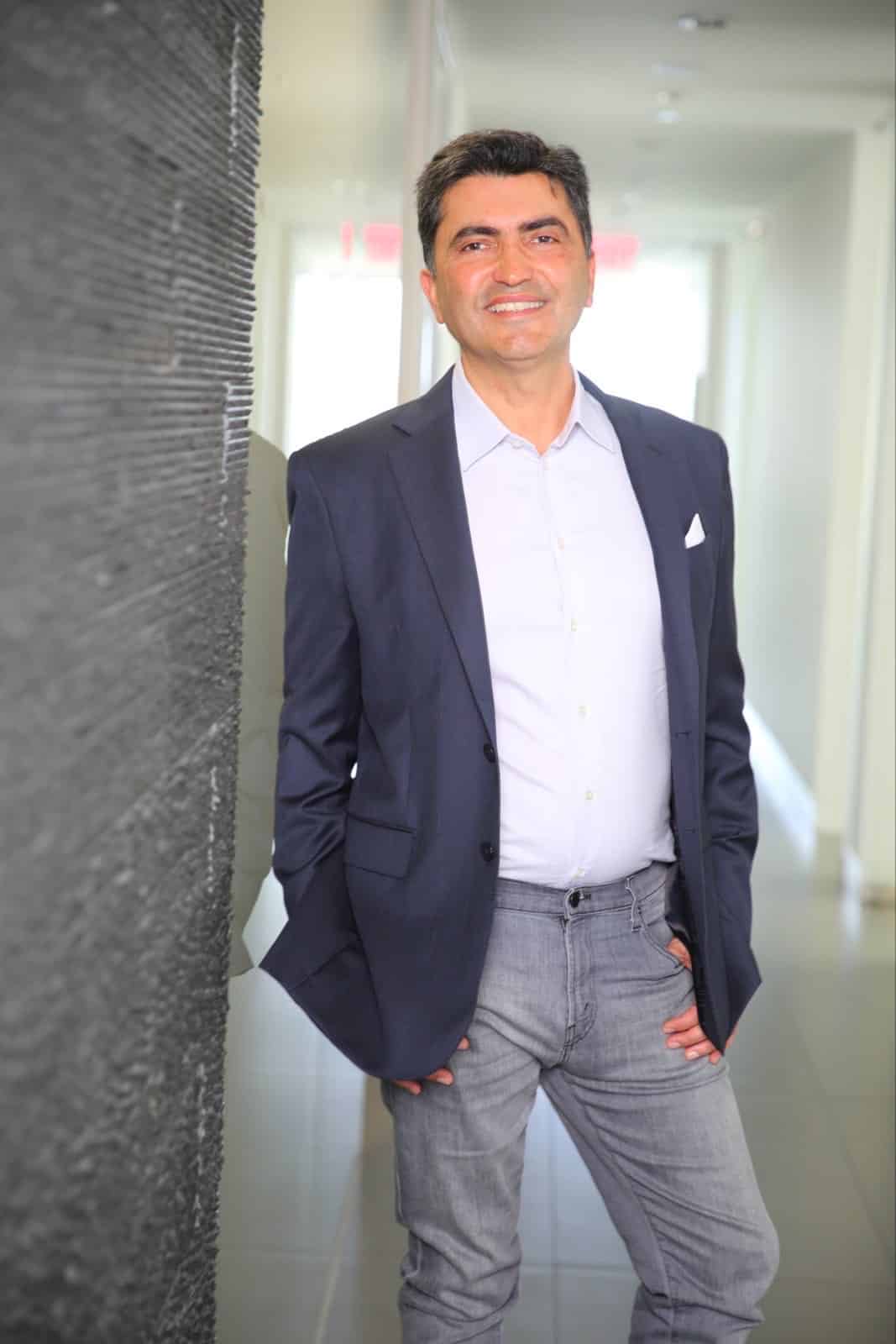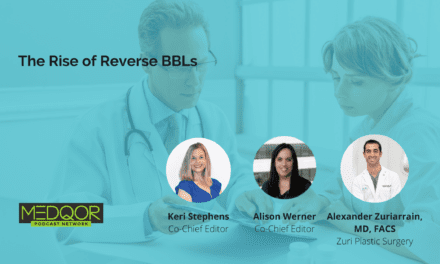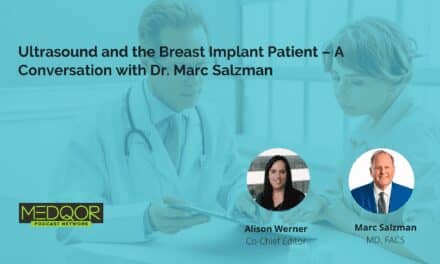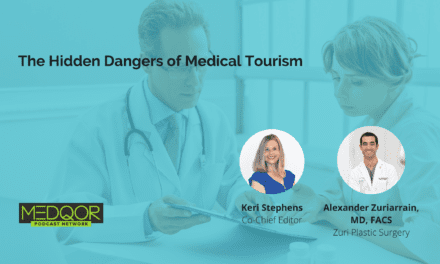In this podcast, we look at facial paralysis, facial reconstruction, and the role of the plastic surgeon, Babak Azizzadeh, MD, FACS, a double-board certified facial plastic and reconstructive surgery, specializing in the field. In this episode:
- Founder and director of The Facial Paralysis Institute and associate clinical professor at the David Geffen School of Medicine at UCLA, Azizzadeh shares how it was a family friend’s experience with facial paralysis while he was doing his residency that sparked his passion for this subspecialty.
- Most of the time, Azizzadeh explains, we don’t think about the 17 muscles on either side of our face—the ones that allow us to express ourselves and control how our mouth for eating and speaking and opening and closing our eyes. The brain and the facial nerve work together seamlessly. But when there is an injury, virus, inflammation, infection, or tumor that interrupts that nerve, the face can stop working normally—and that is when facial paralysis can set in.
- Azizzadeh explains the role of the facial plastic surgeon in managing facial paralysis. He talks about how most plastic surgery is about creating some improvement in symmetry or static procedures, like face lifts. Facial paralysis, on the other hand, requires more dynamic reconstructive efforts to allow the patient to, for example, “smile more naturally, emotionally, and more instinctually, according to Azizzadeh.
- In his breakdown of the procedures in his armamentarium, Azizzadeh explains that no two patients present the same. Facial paralysis, however, can be broken down into two categories which come down to zero activity and some activity. He explains how length of paralysis affects surgical choices and how muscles from other parts of the body can be used introduced where facial muscles have atrophied.
- For patients experiencing facial paralysis caused by Bell’s Palsy, Azizzadeh explains how he is using Botox and physiotherapy to improve patient’s facial movement.
- And then, Azizzadeh talks about his own pioneering work in the field, including his surgery called selective neurolysis to help patients regain the ability to produce natural facial expressions. PSP

Podcast Transcript
Alison Werner 0:10
Hello, I’m Alison Warner host of the plastic surgery practice podcast today I have with me Dr. Babek Azizzadeh, double board certified facial plastic and reconstructive surgery and otolaryngology and Head and Neck Surgery. He is also the director of the facial paralysis Institute in Los Angeles, and as an associate clinical professor at the David Geffen School of Medicine at UCLA. Today he’s going to talk to us about facial paralysis and facial facial paralysis reconstruction. Dr. Azizadeh. Thank you for joining me.
Dr Babak Azizzadeh 0:37
Thank you, Alison. So excited to be here.
Alison Werner 0:39
Great. Well, to get started, can you talk about how you got interested in specializing in facial paralysis and facial paralysis reconstruction?
Dr Babak Azizzadeh 0:48
Yeah, so um, I was, I did my medical school and training at UCLA. And my residency was in head neck surgery. And, you know, facial paralysis was like a teeny teeny part of, you know, our training at that time. And, unfortunately, one of my wife’s really, really close friends had a misdiagnosed brain tumor, ended up developing facial paralysis. And she basically, you know, asked me, oh, my god, she needs, you know, her face fix. And I was like, I don’t know anyone really, that does this. And it was kind of at that time that I got really, really interested in learning more about it. Very few people around the world were really had any real specialization in it. And after I did my facial plastic and reconstructive surgery fellowship at Harvard, I really kind of it was one of my passion projects, of course, majority was like facelifts on rhinoplasty, but this became like a big passion project for me for my practice.
Alison Werner 2:04
Okay, so let’s do a little bit of the basics, because you did mention there that face paralysis is not a big component of the curriculum, what is facial paralysis, what is happening.
Dr Babak Azizzadeh 2:17
So we have 17 muscles on either side of our face, that allows us to express ourselves, happiness, sadness, anger, in addition to controlling our articulation around our mouth, the way or we control food, as well as speech around the mouth and closing of our eyes. So these muscles are controlled by the brain and most of the time, it’s really instinctual movements, we’re not really thinking about it. And the way that the brain is connected to these muscles, but is by the facial nerve, which is essentially a biological wire, right, that connects the brain to these muscles. And this nerve initially travels all all the little micro nerves traveled together, and as they leave the brain and leave the skull, they come into the face and divide up and go into the various muscles and control the various muscles depending on our expression. So any type of injury either in the brain, and the nerve within the brain, and the nerve within the skull or in the face can result in smile or facial dysfunction, and our expressions can be impacted. The most common cause is Bell’s Palsy. And basically Bell’s Palsy is a viral reactivation of the nerve that causes the nerves to stop working temporarily. For most people, they recover completely but about 20 to 30% get a disorganized recovery. Other types some kids are born with Moebius syndrome that can cause facial paralysis or otherwise, you could have tumors of the parotid, you could have brain tumors benign or otherwise. So anything that trauma, anything that interrupts the nerve, Lyme disease, you know, Ramsay hunt syndrome, which is a different type of virus. So all of these things are either virus, inflammation, infection, you know, tumor trauma can cause an interruption of that nerve and if interruption happens, your face stops working normally.
Alison Werner 4:41
So what is the plastic surgeons role in treating facial paralysis?
Dr Babak Azizzadeh 4:48
Yeah, so plastic surgeons typically manage facial paralysis after it’s been set in meaning after a period of time when hasn’t recovered correctly or hasn’t recovered at all? Because you get facial disfigurement right smile, disfigurement, and plastic surgery, again, traditionally was all about just creating some improvement in symmetry, then it was about kind of what we call static procedures where we just lift a face or lift a laugh line. And then over the past 20 years, we have been developing more and more dynamic reconstructive efforts that can allow the individual to smile more naturally, more emotionally, and more instinctually. So you want to kind of with facial paralysis, you know, you want to make the individual look inconspicuous. So when they’re socializing, or they’re going out to the supermarket, someone doesn’t say, Oh, my God, have you had a stroke? And the second thing is, you want to reintegrate them into their social life, so that when they’re sitting across the table, at dinner, or if they’re a teacher, and people aren’t saying, Wait, what’s happening to your face when they’re trying to smile or move their face?
Alison Werner 6:09
So what types of procedures are you most often doing with the various types of paralysis?
Dr Babak Azizzadeh 6:17
That’s a great question. It’s really individualized, very individualized, because there’s no two individuals that have exactly the same situation or circumstance based on their age based on their desire based on their goals. And based on the type of paralysis. If we broadly, you know, separate out facial paralysis into two different categories. One is complete paralysis, where there is zero activity, the nerves have not regenerated, so there’s no movement, everything’s very loose. The second category is a disorganized nerve regeneration, where there is some activity, some muscle movements, something there, but it’s not back to normal. So in individuals who have zero activity, no activity at all, it really depends on how long it’s been that they’ve been inactive because muscles. If they’ve been paralyzed for a period of time, more than two years, typically, they atrophy, we cannot revive those muscles. If it’s less than two years, we can revive those muscles by connecting nerves that maybe go to the tongue, maybe go to the chewing muscle, into the facial nerve to revive the muscles. And then we can do other fancy nerve reorientations and rerouting or muscle transplantations that can help them smile more spontaneously. So for individuals who are fully paralyzed under two years, you try to revive their muscles, that’s really critical. For individuals who are born with facial paralysis, or have had it again, fully paralyzed for more than two years. Their muscles are atrophied. So you have to introduce new muscles to help them smile. And the typically we get muscles from the inner thigh, something called the gracilis muscle, or from the chest called the pectoralis minor muscle to essentially replace the lost muscle. And then we connect the various nerves to them to help the individual smile naturally. And medically, obviously, when you replace a teeny thin, soft, pliable, 17 muscles with one or gracilis muscle, which is really a power muscle, right? Because it’s part of our lower extremity. It’s not going to give you if you’re not going to get to 95% improvement you’ll get you get a dramatic improvement. Right? It’s still not ideal. So that’s kind of the approach I like to use for patients who are fully paralyzed for patients who have what we call synkinesis, which is this disorganized nerve regeneration, which most often happens after Bell’s Palsy. We don’t have a great solution because those other treatments kind of created actually deformities. They weren’t really doing the prop doing really anything. What we found and this is something that I kind of pioneered and really advanced was that we realized that the reason they don’t smile well is because they’re frowning muscles, they’re grimacing muscles. The negative emotional muscles were over active, preventing the smile happiness muscles to work naturally, just
Alison Werner 9:44
Like a misfiring misfiring.
Dr Babak Azizzadeh 9:46
Exactly. I like that. That’s firing. So what we do for individuals like that is two things to three things really, we use Botox targeted and various muscles that works well around the eye. The area very well, we use physiotherapy. And it’s really a lot of relaxation. Therapy is kind of like a cramp of your face, if you think about it. So a lot of stretching and neuromuscular retraining. And then I pioneer the surgery called selective neurolysis, where I actually go in and counter intuitively cut facial nerve branches that are going to the negative emotional muscles. So by releasing and relaxing and reducing the activity of those counterproductive muscles, we allow the small muscles to work better. And since those muscles are connected to the brain as their own facial nerve, it’s super natural results. And we can get sometimes patients in 90-95%, maybe even more improvement in their condition. So that’s kind of the strategic planning. Again, it depends some people don’t want to have surgery. Some people don’t want to have Botox. Some people you know, want, as good as they can get. Some people just want to get some improvement movement. So we try to kind of be well balanced and listen to our patients and make sure that we can get them to their goals. Yeah.
Alison Werner 11:21
How common is it to have a plastic surgeon or a reconstructive surgeon, as part of the care team for someone dealing with facial paralysis?
Speaker 2 11:33
Yeah, I mean, I think there are now more and more, what we call facial nerve centers around the country, but it’s still very, very rare. It’s a very, this is a very complex, it’s not just like, your experience is just complex surgery, microsurgery, and then you need a lot of experience with it. I kind of, you know, it’s like robotic surgery that you know, a lot of, it’s like, you’re good, you become great only after you’ve done hundreds and hundreds and hundreds, and you’re doing it every day. The once in a while robotic surgeons, they just can’t get that good, right. And facial nerve is like that it’s very technically challenging, and a lot of decision making. And those things typically require a lot of experience expertise. And then there’s a humanity to it, right, there’s a compassionate part. And then there’s an understanding of what the individual is looking for. So that’s how we all kind of come together in terms of coming, you know, bringing you the best possible care,
Alison Werner 12:44
would you consider cuz I’m imagining for a patient with facial paralysis patient, there is a larger care team, or do you often find yourself working with other doctors having the kind of that collaborative approach?
Speaker 2 12:56
Yeah, I mean, I would say there are three critical, maybe four critical sub specialists that needs to be involved. Not in every patient, but sometimes we need availability of those. I wear a lot of those hats because I’ve just been doing this for a long time. And I kind of know the little minutiae, but for the most part, you need obviously the plastic surgeon, facial plastic surgeon that that understands nerve transfers, muscle transfers, nerve, I mean those things in the outside, and neurotologist, which is an ENT t that specializes in in the cranial nerves within the bone because that’s where the nerve travels, and sometimes there are tumors there, and so forth. So once in a while we need like I work with a house clinic, we have like a mazing neurotology team there. You need a head and neck oncologist, someone who understands parotid tumors and parotid cancers. So one of my main team members, Dr. Larian is world’s top parotid surgeon, and then you need a physiotherapist, someone who can work with the retraining rehab and so forth. So those are kind of the four critical not all the time do you need those people? Sometimes you don’t? Sometimes you do.
Alison Werner 14:28
Is there is facial paralysis more common in one gender than the other?
Dr Babak Azizzadeh 14:34
No, no, I mean, we we don’t know exactly. Because a lot of people don’t necessarily it goes into a database base. Obviously as a whole in plastic surgery. Women seek out more care than men do. So majority of our patients are female. But I don’t think there’s any particular one You know, gender that has more with the only exception being that Bell’s palsy does tend to occur, not very often, but is associated with pregnancy. So because obviously, that has a, you know, different gender process that tends to have more females.
Alison Werner 15:24
You mentioned a little bit there, how you’re using Botox? Are there other non surgical options that are beneficial in this treatment?
We use Botox, I would say, at the core of what we’re trying to deal with is obviously, muscle nerve dysfunction. But there’s also facial asymmetry that takes place, right, when you have paralysis on one side versus the other. There’s a facial asymmetry. So I am my armamentarium, how to utilize fillers, energy based devices, as well as you know, deep plane facelift and other blepharoplasty techniques to create symmetry. So there are a lot of various aesthetic treatments that we modify, to create better symmetry, like I do a lot of lip lifts to create asymmetrically to create improvement in that position. So some people have like nasal obstruction, we have to do rhinoplasty. So there’s a lot of different techniques that we can use to help but those are the cornerstones.
How has facial paralysis reconstruction kind of evolved over the last decade, 20 years? And are there anything, I think promising, like any promising advancement that you’re kind of keeping an eye on at this point?
Dr Babak Azizzadeh 16:46
So there’s been a huge change, I think, mainly, I would say, over the last two decades, we’ve really improved our outcomes with like gracilis muscle transfer, which is a very important tool, as we talked about for kids and adults with full paralysis, Moebius syndrome, etc. The second, I think the second big advance was the selective neurolysis that’s been really a game changer because the largest population of facial paralysis were Bell’s Palsy and Ramsay hunt syndrome, we had no treatments for them, right, we were really a small percentage ended up having full paralysis. So that was a huge game changer, because we were able to offer treatments when before there weren’t really great treatments. The next phase, I mean, in my heart of hearts, I’m hoping is really understanding better how we can prevent synkinesis prevents disorganized growth, improve nerve regeneration, by a variety of different you know, stem cell approaches, other therapeutic treatments for that, I have been working on a project looking at artificial muscles, that’s a long way away, but that potentially be at some point. Very, very important and the treatment algorithm. So there isn’t any, any, like, major thing that I see at this point. But sometimes it just happens and we don’t know it.
Alison Werner 18:24
What would your advice be to other facial plastic surgeons and reconstructive surgeons who are kind of interested in working more in depth on facial paralysis?
Dr Babak Azizzadeh 18:34
Yeah, I mean, um, um, you know, obviously, when it comes to, you know, technical advances, we’re always evolving, right? You know, I’m not doing the same facelift that was doing 20 years ago. I’m not doing the same rhinoplasty I was doing years ago and eyelid surgery. But facial paralysis is a little bit different. And facial reanimation is a little bit different. I really believe you have to get some form of fellowship training. Because it’s so complicated. There’s so many different angles and viewpoints and techniques. It’s a whole specialty on its own. So I would say for the young trainees, if you have an interest, there are there are a few there’s about four or five facial plastics, fellowships that have a big component or monitored component of facial reanimation. You should look at those. And otherwise, I think it’s I actually think it’s a very hard field to really dive in because it’s not like the nerve procedures were doing. Those aren’t the nerve procedure. Those aren’t procedures that a facelift surgeon does, or blepharoplasty surgeon does or it’s a different process. So I don’t want to ever discourage someone from doing it. But I do think you need really fellowship training.
Alison Werner 19:53
right? So it’s about you know, maybe making having a good relationship to have someone to refer to someone to
Dr Babak Azizzadeh 19:59
say I mean, just like everything else, I mean, I don’t I don’t do 95% of the plastic surgery world, right? So I refer those out. And this is, you know, I would say that, I mean, I’ve always had a philosophy of do the things you love and do the things you do well, and everything else, if there’s someone better and someone has more expertise, it’s really unfair. If there’s access to them, for me to do it, rather than sending them someone else,
Alison Werner 20:27
what excites you about the field?
Dr Babak Azizzadeh 20:29
I mean, I love I, you know, first of all, medicine as a whole is a phenomenal field. If you’re not burnt out, and you love what you do. Surgery, another great aspect, plastic surgery, facial plastic surgery is the, in my mind the best field as long as you do the things you love. And as long as you’re really focusing on becoming the best you can be and providing superior care. And this field I think, combines a few things that are really, really great. Number one, it’s a you know, it’s a hands on field, right? We’re operating or in the surgery, we’re kind of a blend of, you know, surgery, artists, electrical engineer, structural engineer, architect, so you have like, all these different artistic right side of the brain left side of the brain all working together. And that’s why I love I love it. There’s no, you know, no two patients that are alike. Everybody needs something different and wants something different. So it brings brings a level of variety, and excitement and novelty every day. You know, obviously there’s a lot of painful aspects of being a surgeon. We don’t need to get into that that’s on its own. I’m happy to come back at a separate but, but as a whole, it is a really, really fulfilling and positive field.
Alison Werner 21:59
Well, thank you so much for your time and for kind of sharing your experience and you know, the work you’re doing I really appreciate it.
Dr Babak Azizzadeh 22:07
Thank you, Alison. I’m really honored to be here.
Alison Werner 22:10
Well, that’s it for today’s episode. Thank you for listening to the plastic surgery practice podcast. Be sure to subscribe on your favorite podcast network, whether that be Apple podcast, Spotify, Google podcasts, or Amazon music. And be sure to check out plastic surgery practice.com to keep up with the latest industry news. Until next time, take care








